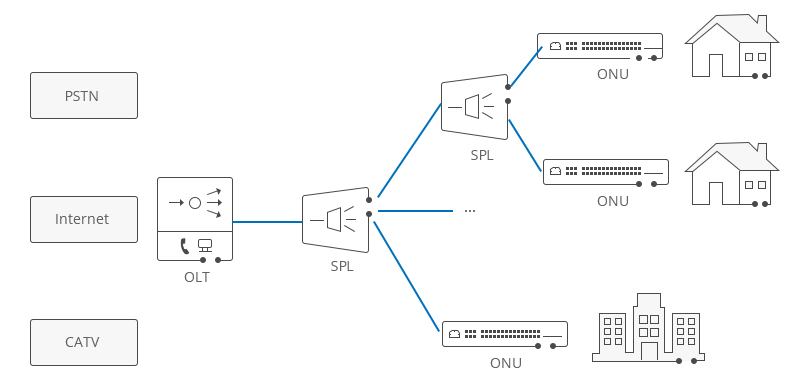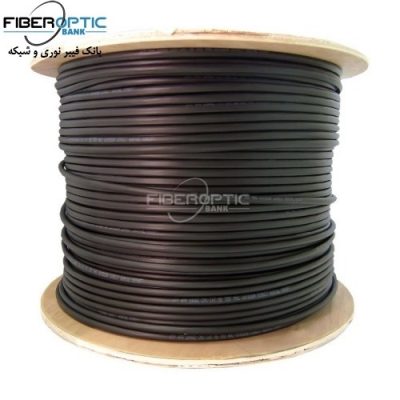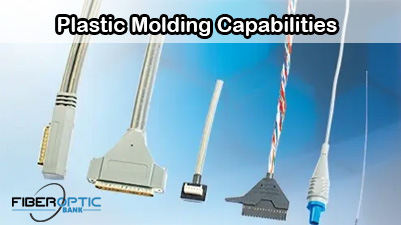Understanding OLT, ONU, ONT and ODN
Fiber to the Home (FTTH) has started to be taken seriously by telecommunication companies around the world, enabling technologies to develop rapidly. Active optical networks (AON) and passive optical networks (PON) are the two major systems that make FTTH broadband connections possible. PON that can provide cost-effective solutions are more ubiquitous in the majority of the FTTH deployments. The ABC of PON will be introduced in this article, which mainly involves the basic components and related technology including OLT, ONT, ONU, and ODN.
PON Explained: Definition, Standards, and Advantages
A passive optical network refers to a fiber-optic network utilizing a point-to-multipoint topology and optical splitters to deliver data from a single transmission point to multiple user endpoints. In contrast to AON, multiple customers are connected to a single transceiver by means of a branching tree of fibers and passive splitter/combiner units, operating entirely in the optical domain and without power in a PON architecture. There are two major current PON standards: Gigabit Passive Optical Network (GPON) and Ethernet Passive Optical Network (EPON). Their topology structures are basically the same. As the first choice in many FTTH deployment scenarios, the PON solution has several prominent benefits:
- Lower Power Consumption
- Less Required Space
- Higher Bandwidth
- Higher-level Security
- Easier to Install and Expand
- Reduced Operation and Management Costs
PON Structure and Components
In a Gigabit Ethernet Passive Optical Network (GEPON) system, there are an optical line terminal (OLT) at the service provider’s central office and a number of optical network units (ONUs) or optical network terminals (ONTs) near end users, as well as the optical splitter (SPL). In addition, the optical distribution network (ODN) is also used during the transmission between OLT and ONU/ONT.
Optical Line Terminal (OLT)
OLT is the starting point for the passive optical network, which is connected to a core switch through Ethernet cables. The primary function of the OLT is to convert, frame, and transmit signals for the PON network and to coordinate the optical network terminals multiplexing for the shared upstream transmission. In general, OLT equipment contains rack, CSM (Control and Switch Module), ELM (EPON Link Module, PON card), redundancy protection -48V DC power supply modules or one 110/220V AC power supply module, and fans. In these parts, PON card and power supply support hot-swap while another module is built inside. The OLT has two float directions: upstream (getting distributing different types of data and voice traffic from users) and downstream (getting data, voice, and video traffic from the metro network or from a long-haul network and send it to all ONT modules on the ODN.) The maximum distance supported for transmitting across the ODN is 20 km.
Optical Network Unit (ONU) / Optical Network Terminal (ONT)
ONU converts optical signals transmitted via fibers to electrical signals. These electrical signals are then sent to individual subscribers. In general, there is a distance or other access network between ONU and end user’s premises. Furthermore, ONU can send, aggregate, and groom different types of data coming from the customer and send it upstream to the OLT. Grooming is the process that optimizes and reorganizes the data stream so it would be delivered more efficiently. OLT supports bandwidth allocation that allows making smooth delivery of data float to the OLT, which usually arrives in bursts from the customer. ONU could be connected by various methods and cable types, like twisted-pair copper wire, coaxial cable, optical fiber, or through Wi-Fi.
End-user devices may also be referred to as the optical network terminal (ONT). Actually, ONT is the same as ONU in essence. ONT is an ITU-T term, whereas ONU is an IEEE term. Belong to different standard bodies, they both refer to the user side equipment in the GEPON system. But in practice, there is a little difference between ONT and ONU according to their location.
Optical Distribution Network (ODN)
ODN, an integral part of the PON system, provides the optical transmission medium for the physical connection of the ONUs to the OLTs with 20 km or farther reach. Within the ODN, fiber optic cables, fiber optic connectors, passive optical splitters, and auxiliary components collaborate with each other. The ODN specifically has five segments which are feeder fiber, optical distribution point, distribution fiber, optical access point, and drop fiber. The feeder fiber starts from the optical distribution frame (ODF) in the central office telecommunications room and ends at the optical distribution point for long-distance coverage. The distribution fiber from the optical distribution point to the optical access point distributes optical fibers for areas alongside it. The drop fiber connects the optical access point to terminals (ONTs), achieving optical fiber drop into user homes. In addition, the ODN is the very path essential to PON data transmission and its quality directly affects the performance, reliability, and scalability of the PON system.
Conclusion
OLT, ONU or ONT, and ODN are the main components in a GEPON system, which have been widely used in the FTTH applications by far. The reduced cabling infrastructure (no active elements) and flexible media transmission contribute to the passive optical networks more ideal for home Internet, voice, and video applications. Additionally, passive optical networks can also be applied in college campuses and business environments, providing cost-effective solutions. As PON technology has continued to improve, the potential applications have expanded as well.
Source: community.fs
Related products...
fiber-optic-cable
fiber-optic-cable


















[ratings]